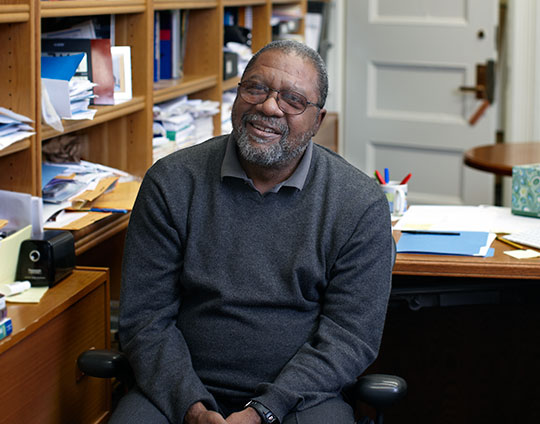When Awareness Isn't Enough
Most racial discrimination suits fail, and the medical world doesn't acknowledge that discrimination causes harm. Robert T. Carter is trying to change the status quo on both counts
Most racial discrimination suits fail, and the medical world doesn’t acknowledge that discrimination causes harm. Robert T. Carter is trying to change the status quo on both counts
By SIDDHARTHA MITTER
FACT: EIGHTY PERCENT OF LEGAL CLAIMS OF RACIAL harassment or discrimination fail.
To Robert T. Carter, Professor of Psychology and Education, that statistic confirms a belief he has acquired over the course of his long career. “People write that racism is generally a socioeconomic condition,” says Carter, an internationally recognized expert on race and diversity issues. “There has not been, until my work, a way to organize encounters into types, with specific relationships to a person’s reaction.”
Carter has written and conducted research on racial/cultural experiences in schools, workplaces and other settings and has been a consultant and expert witness on such topics as school desegregation, employment discrimination, organizational cultural competence and diversity training. His observations and findings have convinced him that people experience symptoms such as nightmares, depression, withdrawal, guilt and physical ailments in the wake of abrupt or repeated incidents in which they are belittled, dismissed or harmed due to race.
Yet among the 52 examples of stresses listed in the current edition of the American Psychiatric Association’s Diagnostic and Statistical Manual of Mental Disorders (DSM-IV), race is not mentioned and discrimination is noted only once. “Essentially, race and racism don’t appear,” Carter says.
The situation is similar on the legal side with respect to recognition of emotional distress in cases of racial harassment or racial discrimination. In the case of sexual harassment, Carter notes, “if you’re a man, and a woman working for you in your office brings a complaint that you said or did something that made her uncomfortable, she doesn’t have to show intent. It’s enough, according to the law, that she was uncomfortable, and corrective action could be taken against you. But the law on racial discrimination or harassment—they are not separated or treated as distinct—says that one has to show intent on the basis of race and that the offending actions must have been committed with racial animus.”
Nearly every organization has a very clear-cut, unambiguous sexual harassment policy and procedures for dealing with violations, Carter says. Yet with regard to race, “It’s just ‘We have an antidiscrimination policy.’ There are no guidelines on how to file an action for racial harassment.”
Carter, who holds an M.A. and an Ed.M. from Teachers College and a Ph.D. from the University of Maryland, says his knowledge of this state of affairs crystallized during a year he spent in 2004 and 2005 working as an Ira Glasser Racial Justice Fellow at the national offices of the American Civil Liberties Union.
“I learned that three amendments to the Constitution were passed to protect the rights of people of African-American descent—the 13th, 14th, and 15th—and that there have been seven Civil Rights Acts passed, the first in 1866. It’s amazing. I hadn’t thought there was anything about civil rights enacted until 1964. Some of the provisions of the 1866 Act are still actionable in court. It gives black people the right to sue and to have hostility-free environments. And yet right now you have to go through hell if you bring a claim for racial harassment.”
Carter himself has helped lay a foundation for change. In 2007, in an article in The Counseling Psychologist, he introduced the concept of “race-based traumatic stress injury,” proposing links between forms of racial discrimination and harassment, how they are experienced, and symptoms and behaviors that result. The article poses categories of avoidance or racial discrimination; hostility or racial harassment; aversive-hostility, and discriminatory harassment. “By grouping encounters this way, you can connect acts to a particular set of reactions that determine that you’ve experienced traumatic stress,” Carter says.
“If I come into a store and they follow me around every moment, or if I go into a work setting and people treat me with hostility or talk over me, those are acts of hostile aversion or hostility. But if I am ignored in a store, that is avoidance.”
In the same article in The Counseling Psychologist, Carter presented a research agenda aimed at creating tools for assessing racial harassment and discrimination and at building a stronger body of evidence on how people are harmed.
Carter also is working on ways to assess the degree to which an institution’s climate encourages diversity. Since he strongly believes that demographics—the proportion of people of color in each professional category, for example—is not enough to predict or prevent a positive or constructive climate for diversity, he wants to build a more comprehensive gauge of the climate for diversity as people actually experience it.
His pilot site is none other than TC itself. Over the past several years, with the College’s blessing, he and Celia Oyler, Associate Professor of Education, have used document analysis, an “inventory of artifacts” or visual cues, interviews, focus groups and a survey to assess TC’s climate in ways that can apply to other institutions.
While the research is ongoing, Carter points out one key finding, which he says is not specific to TC. “It’s true that people, whether they are in the majority or the minority, find issues of race are hard to address,” he says. “Generally, there is a sense within institutions that it’s the responsibility of the people who are bothered by those issues to raise them and promote change. But that’s not effective. Issues with race or diversity are not handled well when they percolate from the bottom. The people who are responsible for an organization need to talk them up.”
Published Thursday, Dec. 15, 2011
